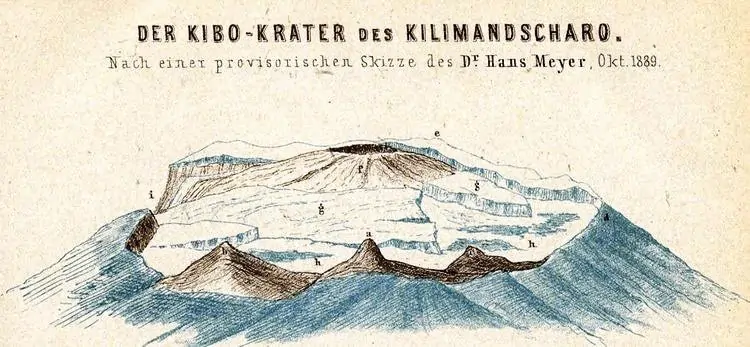 Who were the first people to actually make the summit of Mount Kilimanjaro? First of all, the mountain had to be discovered by Europeans before anyone actually tried to climb it.
Who were the first people to actually make the summit of Mount Kilimanjaro? First of all, the mountain had to be discovered by Europeans before anyone actually tried to climb it.
Mount Kilimanjaro had of course been known by the locals since ancient times. But climbing Kilimanjaro did not actually happen until the 1860s.
Prior to the 1860s, sailors, in ancient times, that traveled along the African coast and on the Nile river mentioned a Moon Mountain to Claudius Ptolemy. Ptolemy, was a Greco-Roman mathematician, astronomer, geographer, and astrologer. He lived in the city of Alexandria in the Roman province of Egypt. Unfortunately, this information was unreliable since this Moon Mountain may or may not have been Kilimanjaro. It could also have been Mount Kenya or even the mountains in Ethiopia.
Additionally, Martín Fernández de Enciso, a Spanish traveler to Mombasa wrote of an “Ethiopian Mount Olympus, which is exceedingly high, and beyond it are the Mountains of the Moon, in which are the sources of the Nile.” But once again, he had not actually seen Mount Kilimanjaro but rather only heard of the mountain through other inland explorers.
The Missionaries

Johannes Rebmann
1840 A more accurate account of Mount Kilimanjaro is from the German missionary and explorer, Johannes Rebmann. Among his many credited feats, he was the first European, along with his colleague Johann Ludwig Krapf, to enter Africa from the Indian Ocean coast. In addition, he claims he was the first European to “find” Mount Kilimanjaro in 1840. English geographer Halford Mackinder and English explorer Harry Johnston substantiated his claim.
However, the dates as to when Rebmann first saw Kilimanajro have been disputed. According to German geology professor Hans Meyer, Rebmann first arrived in Africa in 1846 and has quoted Rebmann’s diary entry of May 11, 1848 as saying, “This morning, at 10 o’clock, we obtained a clearer view of the mountains of Jagga, the summit of one of which was covered by what looked like a beautiful white cloud. When I inquired as to the dazzling whiteness, the guide merely called it ‘cold’ and at once I knew it could be neither more nor less than snow… Immediately I understood how to interpret the marvelous tales Dr. Krapf and I had heard at the coast, of a vast mountain of gold and silver in the far interior, the approach to which was guarded by evil spirits.”
So the claim of Rebmann first seeing Mount Kilimanjaro in 1840 seem to be false. Either way, it was still the first recorded sighting of Mount Kilimanjaro by a European.
The Mountaineers
1861 After the Missionaries came the Mountaineers. In August of 1861, Baron Carl Claus von der Decken, a Hanoverian naturalist and traveler who had been residing in Zanzibar went searching for Mount Kilimanjaro. He was accompanied by an English geologist Richard Thornton. Thornton was also a renowned explorer. He had previously had made an attempt to summit Kilimanjaro. His attempt failed after three days due to bad weather despite having a mountain crew of over fifty porters. He had only gone as high as 8,200 ft.
Von der Decken provided the most accurate estimate for the height of both Kibo – which he guessed was between 19,812 and 20,655 feet. He also guessed that Mawenzi stood between 17,257-17,453 feet. Thornton, also added that the mountain was volcanic, with Kibo being the youngest and Shira the oldest parts of the mountain.
1862 The following year, without Thornton, von der Decken made it as high as 14,200 ft before being turned back due to a snow storm. Upon his return to Europe, the Baron described Kibo as a “mighty dome, rising to a height of about 20,000 feet, of which the last three thousand are covered in snow”.
1871 Twice in 1871, Charles New, a London-born missionary attempted the summt—both in the spring and in August— and both times he was turned away. He did make it as high as 13,000 ft.
1873 New’s failed attempts only further drove him to go back to Kilimanjaro. Two years later he once again set his sights on the summit. Unfortunately, the volatile tribes that called the foot of Kilimanjaro home had other plans for New. Before New ever reached Kilimanjaro he was attacked and stripped of all his possessions as he fled for the coast. He died soon after.
1883 Once the news of News tragedy reached Europe, the excitement surrounding Kilimanjaro diminished. For the next decade, Kilimanjaro remained relatively untouched by outsiders. Europeans that did visit the region usually did so on their way to somewhere else. People such as Dr. Gustav A Fischer in 1883, stopped in Arusha and visited Mount Meru on his journey to Lake Naivasha. He declared Kilimanjaro to be fit for “European settlement”.
During this time, a Scottish geologist, Joseph Thomson, attempted to summit from the north side. However, he only allowed himself one day to do it. He only reached as high as 8,800 ft. Despite his failure, they did name the Thompson Gazelle after him.
The first European to venture back to the region specifically to climb Kilimanjaro was in 1883. In an expedition organized by the Royal Geographical Society, Harry Johnston landed in East Africa specifically to discover and document the flora and fauna of Kilimanjaro. Johnston’s trip—he later claimed in his biography—was not actually for understanding Kilimanjaro, but rather that he was there working undercover for the British Secret Service. There is no evidence to support this claim. Another tale he told was that he reached as high as 16,o00 ft. And that it was a “mountain that can be climbed even without the aid of a walking stick”. He was widely ridiculed for his claims. But his claims did reignite the desire for Europeans to once again attempt Kilimanjaro’s summit.
1887 During his first attempt to climb Kilimanjaro, the German geology professor Hans Meyer reached the lower edge of the ice cap on Kibo, where he was forced to turn back because he lacked the equipment needed to handle the ice. The following year, Meyer planned another attempt with Oscar Baumann, a cartographer, but the mission was aborted after the pair were held hostage and ransomed during the Abushiri Revolt.
1888 In the autumn of 1888, the American naturalist Dr. Abbott and the German explorer Otto Ehrenfried Ehlers approached the summit from the northwest. While Abbott turned back earlier, Ehlers claimed to have reached the summit rim, but after severe criticism of that claim, he later withdrew it.
Success
1889 Meyer returned to Kilimanjaro with the Austrian mountaineer Ludwig Purtscheller for the third attempt in 1889. This time they were successful at reaching Kilimanjaro’s summit. They were able to successfully summit due to the strategy of creating several camps as they ascended. At these camps, they had plenty of food and supplies. That way they could make multiple attempts without having to descend to resupply. Meyer and Purtscheller pushed to near the crater rim on October 3 but turned around exhausted from hacking footsteps in the icy slope.
Three days later, on Purtscheller’s fortieth birthday, they reached the highest summit on the southern rim of the crater. They were the first to confirm that Kibo has a crater. After descending to the saddle between Kibo and Mawenzi, Meyer and Purtscheller attempted to climb the more technically challenging Mawenzi but could reach only the top of Klute Peak, a subsidiary peak, before retreating due to illness. On October 18, they reascended Kibo to enter and study the crater, cresting the rim at Hans Meyers Notch. In total, Meyer and Purtscheller spent 16 days above 15,000 ft. during their expedition. They were accompanied in their high camps by Mwini Amani of Pangani, who cooked and supplied the sites with water and firewood.



